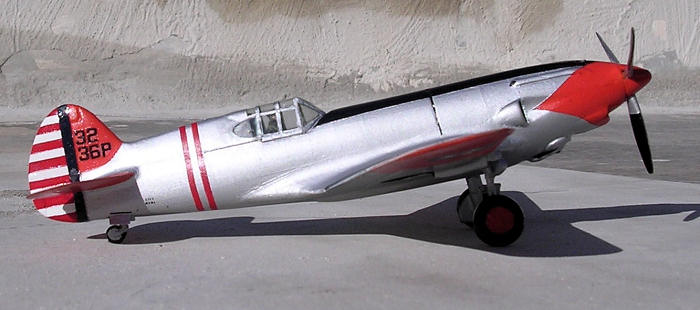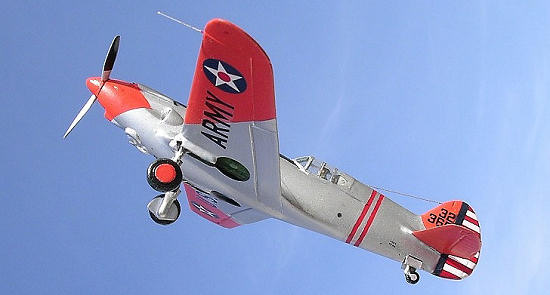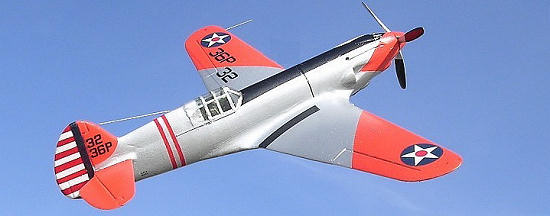Rarebits/Monogram 1/72 YP-37
|
KIT: |
Rarebits/Monogram 1/72 YP-37 |
|
KIT #: |
? |
|
PRICE: |
£2.00 |
|
DECALS: |
None |
|
REVIEWER: |
Carmel J. Attard |
|
NOTES: |
Vacuformed conversion |

Circa
mid 1930
America
along with other countries was in the midst of modernising aircraft to be
capable of operating in hot weather terrain as the western
United States
for desert testing, and some other place for low temperature cold weather
testing. In the latter case
Alaska
offered the ideal spot more than any other state. Ladd field provided a suitable
place for US Army Air Corps to test aircraft and equipment under extreme cold
weather conditions.
 Two
B-17s were set ready at the Sacramento Air Depot for cold weather experimental
work. When preparations were complete six officers and eighteen men that
comprised crew of two aircraft departed for
Alaska.
They were met by Maj.Gaffney on their arrival at Ladd airport. The crew bundled
in fur-lined boots and flying togs lumbered out of the two planes. They expected
to find natives at
Fairbanks
dressed as if living in ice boxes; instead they were dressed in clothing
normally found in lower 48 degrees Fahrenheit.
Two
B-17s were set ready at the Sacramento Air Depot for cold weather experimental
work. When preparations were complete six officers and eighteen men that
comprised crew of two aircraft departed for
Alaska.
They were met by Maj.Gaffney on their arrival at Ladd airport. The crew bundled
in fur-lined boots and flying togs lumbered out of the two planes. They expected
to find natives at
Fairbanks
dressed as if living in ice boxes; instead they were dressed in clothing
normally found in lower 48 degrees Fahrenheit.
They
began work in earnest and eventually sufficient data has been gathered
concerning northern conditions to warrant a flight to the materials division at
Dayton
Ohio
and a conference with Air Corps engineers there. The Air Corps was particularly
interested in ski operations and development of ski for all types of aircraft.
These were still a somewhat limited testing and in conjunction with the advice
given by the local experienced Alaskan pilots several tentative conclusions were
reached. Only light aircraft could operate with any regularity from unprepared
areas. The report also suggested that further testing be conducted at a later
date.
Two
B-17s and two Curtiss YP-37s had arrived with Maj.Gaffney in April 1940. One
YP-37 and a B-17B were lost during the first season of testing. In spite of all
the flying crew still managed to log over 800 hours of flying time. By October Ladd field provided the base for two of each of the current aircraft.
They had winterisation equipment incorporated through either production or
modification. In spite of requests and varied promises, deliveries of some
aircraft were delayed. One of these aircraft a YP-37 that was prepared for
operations in
Alaska
had bright international orange painted on standard areas to the forward
fuselage and wings for any eventual accident in the snow terrain and thereby
could be easily detected from the air.
By October Ladd field provided the base for two of each of the current aircraft.
They had winterisation equipment incorporated through either production or
modification. In spite of requests and varied promises, deliveries of some
aircraft were delayed. One of these aircraft a YP-37 that was prepared for
operations in
Alaska
had bright international orange painted on standard areas to the forward
fuselage and wings for any eventual accident in the snow terrain and thereby
could be easily detected from the air.
The
cold weather testing during the cold season was not a complete waste. They
learned that major difficulties was not with aircraft but with the personnel,
since it was difficult to maintain the equipment while wearing the bulky clothes
necessary to keep them warm. Aircraft that have been exposed to extreme cold
should be left outside. Constant movement in and out of the hangar caused
aircraft to sweat and this compounded problem of operation. The alternative
thawing and freezing caused hydraulic problems, broken seals and fractures
windshields and canopies. A lesson learned well, for modern aircraft are either
hangared or left on the ramp, but they are not normally shuttled around. The
testing and experiments also relied on analysis of cold weather operations of
allied and even enemy nations. Results of the German Air Force against
Russia
during the winter of 1940-41 and
 lessons
learned by th Air Transport Command in flying aircraft over the Northern ferry
route were also studied. Russian officers who had fought against Germans during
periods of extreme cold weather described
their successes against Germans
were
due to German
aircraft that
were not capable of operating under extreme low temperature.
lessons
learned by th Air Transport Command in flying aircraft over the Northern ferry
route were also studied. Russian officers who had fought against Germans during
periods of extreme cold weather described
their successes against Germans
were
due to German
aircraft that
were not capable of operating under extreme low temperature.
The
results indicated that as a basic requirement of combat aircraft, the Army Air
Force had to be capable of operations under extremely low temperature
conditions, as low as minus 65 Fahrenheit. In addition to testing aircraft,
the cold weather test detachment also performed extreme testing on clothing and
other materials.
The
experimental Allison-powered XP-37 produced in 1937 therefore gave its share in
the cold weather tests conducted in
Alaska.
Although the XP-37 engine/supercharger combination was quite troublesome the
USAAC realised the potential of the concept and apart from the cold weather
tests, there were thirteen service test aircraft with
the V-1710-21 engine, revised nose contours, a 25” lengthening
of the fuselage to the cockpit for balance and directional stability purposes.
Still it was plagued with supercharger problems and all but one went out of
service or retired by early 1942.
A
parallel design was the XP-40 which proved more suitable and was developed into
the extensive P-40 fighter series, thereby bringing an end to the brief history
of the YP-37.
The Curtiss YP-37 comes in a polythene pack and is quite a
basic kit consisting of two fuselage halves and a conical spinner all vac formed
in white plastic. The pack also includes a vac form clear canopy. This was
unfortunately damaged but with some
 effort it
still could be salvaged. An instruction sheet of an A4 size depicts a two tone
picture of a typical completed model
and there is also a side view
to suggest an operational silver overall livery of the
type which was attached to the 10th
Air |Base Squadron, Chanute Field,
Rantoul,
Illinois
in 1939. Two smaller view scale plans give indication of work needed to the wing
roots.
effort it
still could be salvaged. An instruction sheet of an A4 size depicts a two tone
picture of a typical completed model
and there is also a side view
to suggest an operational silver overall livery of the
type which was attached to the 10th
Air |Base Squadron, Chanute Field,
Rantoul,
Illinois
in 1939. Two smaller view scale plans give indication of work needed to the wing
roots.
The fuselage
parts are first cut from the backing sheet and the edges are sanded to make a
good centreline joint. Several ¼ inch plastic tabs were added along the inside
of the joining edge. Internal cockpit details were added using parts from a kit
of the P-75. The instruction suggests using a Revell or Heller Hawk 75 besides
the Monogram kit for the provision of wings and undercarriage. Here are side air
intakes on the front nose which were opened and a blanking piece was added to
the inside of fuselage to avoid the see through effect. The interior was painted
zinc chromate. I have used parts from the Monogram Curtiss Hawk 75A-3 Kit No
74007-0389. The wings and undercarriage were assembled and fitted to the vac
form fuselage. This did not quite provided a perfect joint and some putty
carefully applied produced a smooth faired wing root. The kit propeller was
added and the conical spinner carefully cut shaped and inserted to the prop
front. The prop was to fit at a later stage. Small fairings were added to the
leading edge in way of the wing root using Revell Plasto filler. Gun positions
were drilled at the upper nose so that small hollow metal tubes were inserted to
simulate the front end of nose guns. Finally a tail wheel added.
 This was
another type of aircraft that spent time in
Alaska's
wonderland mainly for cold weather trials. In fact I chose to finish in the
colour scheme in which it operated. Thanks to Lars Opland of
Wasilla,
Alaska
who sent me very relevant information about the YP-37’s Alaskan connection as
well as a picture of the aircraft in the vivid markings. The conspicuous colours
consisted of bright red/orange areas at nose, and wing tips, not much different
from the markings applied to the Martin B-10 that appeared on MM some time ago.
I have used Model Master Italian red 2719E for the bright areas simulating a
bright type of international orange. The rest of the aircraft was silver. The
interiors were zinc chromate. A black serial number, wing walkways decal strip
and black anti glare panel were added from spare decal box.
This was
another type of aircraft that spent time in
Alaska's
wonderland mainly for cold weather trials. In fact I chose to finish in the
colour scheme in which it operated. Thanks to Lars Opland of
Wasilla,
Alaska
who sent me very relevant information about the YP-37’s Alaskan connection as
well as a picture of the aircraft in the vivid markings. The conspicuous colours
consisted of bright red/orange areas at nose, and wing tips, not much different
from the markings applied to the Martin B-10 that appeared on MM some time ago.
I have used Model Master Italian red 2719E for the bright areas simulating a
bright type of international orange. The rest of the aircraft was silver. The
interiors were zinc chromate. A black serial number, wing walkways decal strip
and black anti glare panel were added from spare decal box.
This
kit build was yet another aircraft that with an extra bit of research has
evolved an interesting colourful livery which turned it into an eye catcher
aircraft having a short life but interesting history behind it.
Ref
1:
Top Cover for
America,
the Air Force in
Alaska
1920-1983 by John Haile Cloe
&
Michael F. Monaghan.
 Ref
2:
“Arctic Warbirds” by Steve Mills
Ref
2:
“Arctic Warbirds” by Steve Mills
Carmel J. Attard
May 2008
If you would like your product reviewed fairly and quickly, please
contact
me or see other details in the
Note to
Contributors.
Back to the Main Page
Back to the Review Index Page



 By October Ladd field provided the base for two of each of the current aircraft.
They had winterisation equipment incorporated through either production or
modification. In spite of requests and varied promises, deliveries of some
aircraft were delayed. One of these aircraft a YP-37 that was prepared for
operations in
By October Ladd field provided the base for two of each of the current aircraft.
They had winterisation equipment incorporated through either production or
modification. In spite of requests and varied promises, deliveries of some
aircraft were delayed. One of these aircraft a YP-37 that was prepared for
operations in  lessons
learned by th Air Transport Command in flying aircraft over the Northern ferry
route were also studied. Russian officers who had fought against Germans during
periods of extreme cold weather described
their successes against Germans
were
due to German
aircraft that
were not capable of operating under extreme low temperature.
lessons
learned by th Air Transport Command in flying aircraft over the Northern ferry
route were also studied. Russian officers who had fought against Germans during
periods of extreme cold weather described
their successes against Germans
were
due to German
aircraft that
were not capable of operating under extreme low temperature. effort it
still could be salvaged. An instruction sheet of an A4 size depicts a two tone
picture of a typical completed model
and there is also a side view
to suggest an operational silver overall livery of the
type which was attached to the 10th
Air |Base Squadron, Chanute Field,
effort it
still could be salvaged. An instruction sheet of an A4 size depicts a two tone
picture of a typical completed model
and there is also a side view
to suggest an operational silver overall livery of the
type which was attached to the 10th
Air |Base Squadron, Chanute Field,  This was
another type of aircraft that spent time in
This was
another type of aircraft that spent time in 